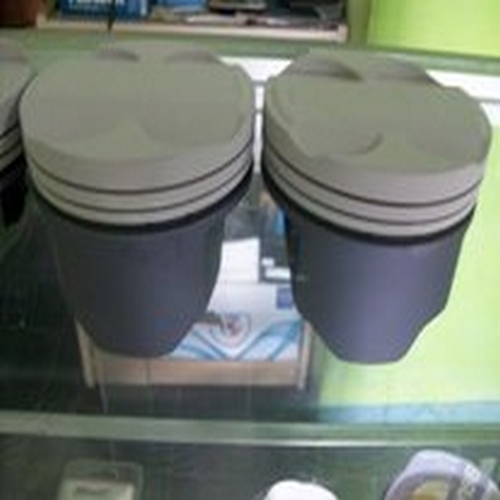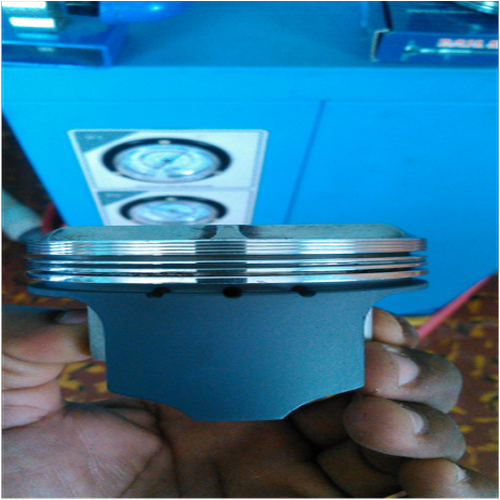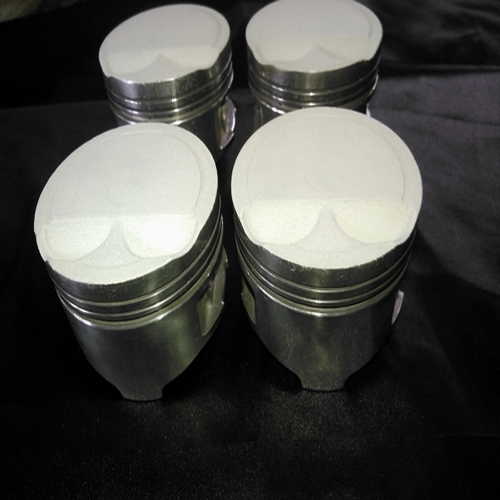Customers used piston.

Customers used piston

Crown and skirt coating




Piston coating is a valuable technology for improving the performance and longevity of internal combustion engines. Here’s a breakdown of how various types of piston coatings can benefit your engine:
Piston Crown Coating: The coating on the piston crown serves to insulate the piston from excessive heat. When an engine runs, especially at high loads and speeds, the piston crown can become extremely hot. Heat weakens metals, and if the piston crown gets too hot, it can deform or even crack. The coating acts as a thermal barrier, helping to keep the piston cooler and more structurally sound.
Piston Skirt Coating (Anti-Friction Coating): This coating on the piston skirts serves a dual purpose. First, it reduces friction between the piston and the cylinder wall, which not only conserves energy but also minimizes wear and tear on these critical components. Second, by reducing friction and heat, it can extend the life of your engine and improve overall efficiency.
Detonation Threshold Reduction: By keeping the piston cooler, the coating helps lower the detonation threshold. This means you can run the engine with more advanced timing, potentially resulting in increased power and efficiency.
Protection Against Sliding Friction: Coating on the piston skirts minimizes sliding friction, which is a major source of heat and wear in an engine. This added protection can help extend the life of your pistons and engine block.
Nitrous Oxide Compatibility: Some piston coatings are designed to protect nitrous oxide-injected engines. Nitrous oxide can introduce extreme stresses and temperatures into the combustion process, and a suitable piston coating can help mitigate these effects.
Reduction of Friction in Piston Assembly: The piston assembly, which includes the piston, rings, and rod, contributes significantly to friction in the engine. Piston coatings, especially on the skirts, can reduce friction in this assembly, improving overall engine efficiency.
Friction Distribution: Friction in an engine is distributed among various components. According to the information you provided, the piston assembly (including the piston) is responsible for around 50 percent of the friction. The valve train, crankshaft bearings, and accessories make up the remaining 50 percent. Therefore, focusing on the piston assembly is a logical step in reducing friction and improving engine performance.
In summary, piston coatings offer several benefits, including improved heat resistance, reduced friction, extended engine life, and enhanced performance. These coatings can be especially valuable for high-performance and high-stress applications, such as those with nitrous oxide injection. However, it’s essential to select the appropriate type of coating and ensure proper installation for the best results in protecting and optimizing your engine.
Piston coating and thermal management in internal combustion engines are important aspects of engine performance and efficiency. Let’s delve into some key points regarding these topics:
Heat Loss in Internal Combustion Engines: It’s true that internal combustion engines are not very efficient in terms of converting the heat generated from combustion into useful work. Much of the heat is lost through various mechanisms, such as cooling systems and exhaust. This inefficiency is one of the reasons why engine design and technologies have been continuously evolving to improve efficiency.
Heat Absorption by Engine Components: Internal combustion engines do absorb a significant amount of heat into their various components, including pistons, combustion chambers, valves, connecting rods, and engine blocks. This heat can have a detrimental effect on these components, leading to wear and reduced engine lifespan.
Piston Coatings: One way to mitigate the impact of heat on engine components is by using piston coatings. These coatings, such as thermal barrier coatings, can help in reducing the temperature of pistons, increasing the detonation threshold, and extending the life of the pistons. They can also reduce piston skirt friction and wear.
Thermal Efficiency: Improving thermal efficiency is a key goal in internal combustion engine design. By minimizing heat loss and maximizing the conversion of heat into useful work (kinetic energy), engines can produce more power with less fuel. Coatings on components like pistons and cylinder heads can contribute to this goal.
Preventing Hot Spots: Hot spots in the combustion chamber can lead to detonation, which can be harmful to the engine. Detonation can cause engine knock and damage internal parts. Coating the cylinder heads, combustion chambers, and valve faces with materials like ceramics can help distribute and manage heat more effectively, preventing these hot spots.
Ceramic Coating: Ceramic coatings are known for their excellent thermal insulation properties. They can help maintain a more consistent and controlled temperature in critical engine components, which is vital for both performance and durability.
In summary, the use of coatings and platings on engine components like pistons and cylinder heads can significantly contribute to improving the efficiency and longevity of internal combustion engines. These coatings help manage heat, prevent hot spots, and ultimately enhance engine performance and reliability. By reducing heat loss and preventing overheating, engineers can work towards achieving a better balance between power output and fuel consumption, ultimately saving money for vehicle owners.
Piston Skirt: The piston skirt is a load-bearing surface that helps keep the piston properly aligned within the cylinder bore. It plays a crucial role in maintaining alignment, especially when the connecting rod is at an angle to the cylinder axis.
Piston Lands and Skirts: These components carry the sliding load that occurs when the connecting rod is at an angle to the cylinder axis, and they contribute to the proper functioning of the piston assembly.
Oil Rings: Oil rings are responsible for controlling the lubrication between various surfaces within the engine, including the piston assembly and the cylinder liner. They play a role in ensuring proper lubrication while controlling oil consumption.
Compression Rings: Compression rings have several key functions, including sealing the clearance between the piston and cylinder to retain gas pressure, minimizing blow-by, and controlling piston temperatures by assisting in heat transfer to the cylinder walls and coolant.
Piston Assembly Friction: The piston assembly is a significant source of friction within the engine. Components such as compression rings, oil control rings, piston skirts, and piston pins all contribute to this friction.
Forces Acting on the Piston Assembly: The text mentions various forces acting on the piston assembly, including:
- Static Ring Tension: This force depends on the design and materials of the rings.
- Gas Pressure Forces: These forces depend on the engine load and are related to maintaining gas pressure within the cylinder.
- Inertia Forces: These forces are related to the mass of components and engine speed, affecting the piston assembly’s behavior.
Design Factors Influencing Velocity: The text refers to design factors that influence the velocity between the various surfaces within the piston assembly. It seems that the velocity between these surfaces is a critical parameter in the context of engine performance and friction.
Equation and Friction Analysis: The text alludes to an equation that, when combined with appropriate piston assembly friction analysis, allows for the calculation of various parameters. These parameters include coupled film and ring tension, ring gap (which affects inter-ring gas pressure), liner temperature, and ring behavior.
In summary, this text provides insights into the importance of various components within a piston assembly, their functions, and the forces and factors that influence their performance within an internal combustion engine. It underscores the significance of proper design and lubrication to reduce friction and improve engine efficiency.
The forces acting on the piston assembly include:
Static ring tension (which dependson ring design and materials) the gas pressure forces (which depend on engine load); the inertia forces (which are related to where h is the local film thickness, p the liquid viscosity, and U the relative component mass and engine speed). The major design factors which influence velocity between the two surfaces.
This equation, along with the appropriate piston assembly friction are the following: ring width, ring face profile, ring force balances on the ring, can then be solved for the coupled film and ring tension, ring gap (which governs inter-ring gas pressure), liner temperature, ring- behavior.